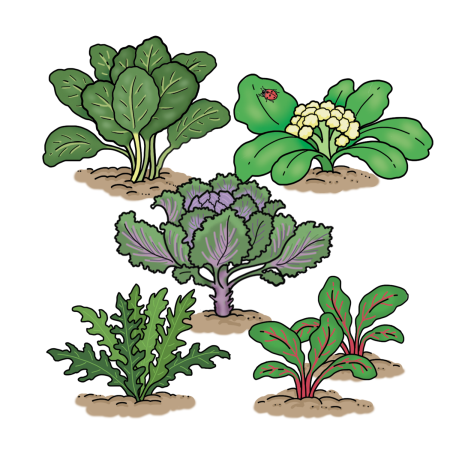
- Put your garden plan into action!
- Check the weather. If the forecast calls for rain, you don't need to water.
- Read the back of seed packets to see how to space plants: spacing them properly will help prevent diseases and pests.
- Spring is slug season! Time to put out traps and watch for damage to young plants.
- Two weeks after planting, add an all-purpose garden fertilizer with a ratio such as 4-4-4.
Kids Can!
Show kids the good bugs in the garden, like ladybugs, butterflies, and bees.
Planting Chart
| Planting Tips | Coastal | Western valleys | High elevations | Columbia/Snake River valleys |
|---|---|---|---|---|
| Start seeds indoors | Almost time to start seeds for fall! | Eggplants, peppers, tomatoes | Melons, cucumbers, kohlrabi, lettuce, pumpkins, chard | Melons, cucumbers, pumpkins |
| Start seeds outdoors | Most veggies have been planted! | Corn, dill, green beans, winter squash, zucchini | Carrots, chives, onions, parsley, parsnips, peas, spinach, turnips | Arugula, beets, chives, onions, parsley, parsnips, potatoes, turnips |
| Transplant outdoors | There is still time for warm-season veggies! | Basil, peppers, melons, celery, cucumbers, eggplant, oregano, rosemary, tomatoes | Broccoli, cabbage, cauliflower, kale, kohlrabi, lettuce, chard | Broccoli, cabbage, cauliflower, kale, kohlrabi, lettuce, chard |
Where is your garden?
Oregon has four growing regions. Choose vegetable varieties and planting dates suitable to the growing conditions in your area:

- Oregon coast: cool, long season of 190 to 250 days.
- Western valleys: 150 to 250-day season; warm days, cool nights; length of season varies year to year.
- High elevations: short growing season of 90 to 120 days; frost can occur during any month.
- Columbia and Snake River valleys: 120 to 200-day season; hot days, warm nights; length of season fairly well defined.


